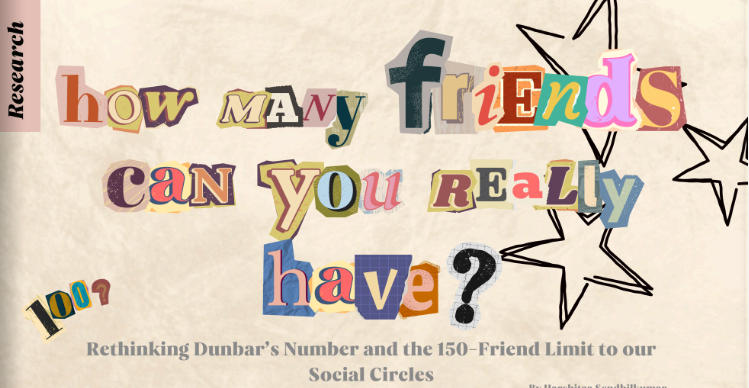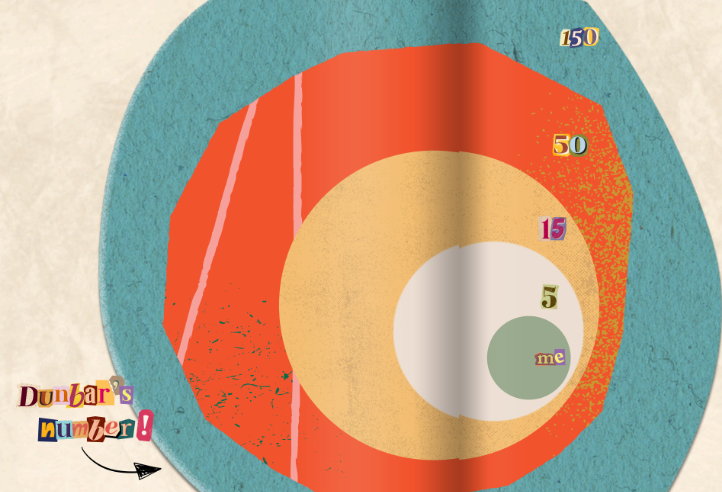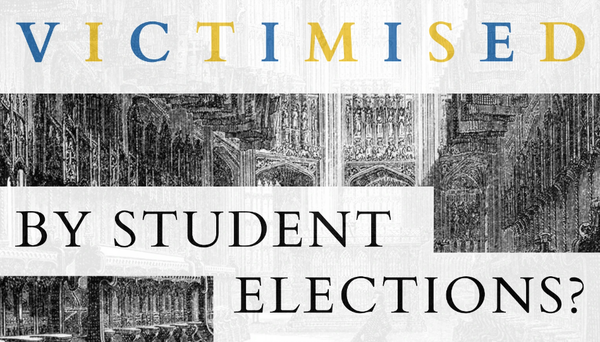How Many Friends Can You Really Have?

Rethinking Dunbar’s Number and the 150-Friend Limit to our Social Circles
Harshitaa Sendhilkumar
Ever find yourself eagerly committing to plans, only to later dread the thought of socialising? Suddenly, your bed becomes the most inviting place on Earth, and the urge to cancel feels like the most logical thing in the world…
It’s a familiar feeling: after committing to a social event, you start questioning whether you’ve overextended your social energy, wondering if you’ve hit an invisible limit to your social capacity. Well, perhaps this limit isn’t so invisible after all - maybe it is 150 people. According to British anthropologist and evolutionary psychologist Robin Dunbar, this number represents the maximum number of meaningful relationships we can maintain at once - a concept known as ‘Dunbar’s Number’.
The Origins of Dunbar’s Number: Tracing the Roots of Human Connection
Robin Dunbar first proposed the concept of ‘Dunbar’s Number’ in the 1990s, but the underlying idea of a cognitive limit on the number of stable social relationships we can maintain predates his coining of the term. Philosophers, such as Aristotle and Plato, theorised about the optimal size of communities for fostering cohesion and balance. Charles Darwin’s evolutionary studies highlighted the social structures of primates, indicating inherent social limits linked to survival and cooperation.
These early insights formed the foundation for the notion that exceeding a natural group size risks societal strain and dysfunction. It was Dunbar, however, who shifted the focus from societal groups to the individual, grounding this concept in empirical research. Through his social brain hypothesis, he formalised the now-famous figure of 150 as the threshold for stable, meaningful connections.
Although the number 150 is the most widely recognised, Dunbar actually proposed a series of six social layers, with a decreasing level of intimacy as the group size increases.
He categorised these connections as:
- Support clique (5 people): The innermost circle of your closest confidants - family and friends - whom you rely on for emotional and practical support.
- Sympathy group (15 people): A broader circle of close friends and relatives
- Affinity group (50 people): People you maintain meaningful relationships with even if interactions may be less frequent, such as friends, extended family or colleagues.
- Full active network (150 people): A network encompassing everyone you can realistically maintain stable, meaningful connections with.
- Acquaintances (500 people): Individuals you recognise and may interact with but do not maintain a consistent, deep relationship with, such as distant colleagues, old classmates, people you contact infrequently on social media.
- Broader network (1500 people): The outermost layer of people you can name and recognise and share superficial interactions with.
The outer layers of acquaintances and the broader network are significantly larger in size, demonstrating the limits of human memory and recognition capabilities rather than the emotional and cognitive investment needed for maintaining meaningful relationships with the inner layers.

So, how did Dunbar derive these numbers?
“I was pondering a graph of primate group sizes plotted against the size of their brains: the larger the brain the larger the group size. I was curious to know what group size this relationship might predict for humans. The number my calculations gave was 150. Since this seemed low, I hurried off to the library to look for data on natural human group sizes.” [Professor Robin Dunbar, Department of Experimental Psychology, University of Oxford]
Dunbar’s research found that, in primates, a larger neocortex (the outermost part of the cerebral cortex involved in cognitive abilities, communication and social behaviour) is associated with a larger social group. Through analysing this trend, he extrapolated that humans would naturally have a social group size of around 150 individuals, given the size of our neocortex. He further supported this hypothesis with historical, anthropological and contemporary psychological data, noting that many social groups, ranging from early hunter-gatherer societies and village communities to the modern Christmas card lists, had group sizes remarkably close to 150. Groups exceeding this threshold tended to fragment or collapse.
This suggested that the figure represented many naturally-forming groups across various domains and cultures, thus, he concluded that this ratio between brain sizes and group sizes limits the degree of complexity a social system can handle. Given that the values were calculated using averages and acknowledging the inherent variation between individuals, all the proposed Dunbar’s numbers (5, 15, 50, 150 etc.) are not rigid figures, but rather represent a range, to depict the general cognitive and social limits of human relationships.
‘
Our Digital Age: Is 150 Still the Limit in a World of Infinite Connections?
Dunbar’s number has served as a flexible framework, being used across various disciplines: optimising workplace design, shaping social media platforms, urban planning, structuring military and police units, designing virtual and gaming communities and mental health initiatives advocating for strong close-knit social ties. It is evident that Dunbar’s number has had a lasting impact, but, recent studies have questioned its validity in light of modern technological and social developments.
There have been debates contesting whether the stable social relationship limit truly remains around 150, following the rise of social media and digital communication increasing the number of connections made, as evidenced by a 2021 analysis showing that users frequently maintained hundreds of relationships online. Dunbar argues that his theory withstands as the psychological quality of online connections can often be weaker than face-to-face relationships, therefore only few of these connections would fit his definition of ‘meaningful’ relationships, as Dunbar’s number of 150 applies to quality relationships, rather than the acquaintances of the outer layers of our social networks.
However, research conducted on various social groups in the US suggests otherwise, as the study identified an average network of around 231 people, with some estimates reaching 291 - almost double Dunbar’s proposed value. This indicates the possibility of an adaptation of human social capacities as a response to modern lifestyles. While this aligns with Dunbar’s broader observation that community sizes increase over time (as earlier humans had smaller brains and correspondingly lower cognitive capacity for managing relationships), the speed of these contemporary changes appears too abrupt to result from evolutionary mechanisms alone. Instead they may support some critics’ view that the social network limits are highly contextual as they are influenced by environmental factors, such as profession, cultural practices and personal preferences.
A pivotal study carried out by researchers at Stockholm University directly challenged the validity of Dunbar’s number, questioning both its empirical foundation and its relevance. They scrutinised the core assumption linking brain size to group size, suggesting that this relationship was oversimplified when applied to humans. By revisiting Dunbar's methodology with updated data and statistical models, the researchers conducted a similar analysis, aiming to replicate the original findings.
The results were strikingly different. The study produced a 95% confidence interval spanning from 5 to 292 possible relationships - in other words, statistically insignificant. The researchers concluded that such a wide range undermines the specificity and utility of Dunbar’s number, branding it as “a concept with limited theoretical foundation and lacking robust empirical support.” They went so far as to advocate for discontinuing its use in both scientific discourse and popular culture.
This critique highlights a growing tension in the modern understanding of human social capacity. While Dunbar’s number remains a useful framework for thinking about relationship dynamics, the Stockholm study underscores the need for caution when interpreting it as a universal or fixed limit, especially in light of cultural, technological, and methodological advancements.
More Than a Number: The Essence of Human Connection
Is Dunbar’s number 150 or 300 or 1000? Is it a fixed rule or does it evolve as social dynamics shift? And, perhaps the biggest question of all: does Dunbar’s number even exist, or is it just a fancy way of saying, “I’m too tired to go out tonight”?
Ultimately, whether or not Dunbar’s number exists as a precise quantity is secondary to its broader implications. While researchers may debate the exact value, the core underlying principle remains widely accepted. Dunbar’s number prompts us to reflect on the limits of our social energy, the importance of cultivating deep, meaningful connections, and the challenges of maintaining intimacy in an increasingly connected world.
Studies consistently show that people derive greater satisfaction from a small, tight-knit circle of connected individuals than from a larger network of acquaintances or ‘weak-ties’. Overextending ourselves across these weaker connections, driven by societal pressures to remain socially active, can lead to burnout and ‘empathy fatigue’ - a phenomenon where individuals feel emotionally drained by the constant demands of social interaction. This emphasises the need to prioritise our own emotional well-being, taking time for ourselves as well as building genuine, fulfilling relationships. Regardless of the number, the theory encourages us to acknowledge the importance of human connection; it underscores our innate need for supportive relationships as social beings.
So, the next time you feel overwhelmed by your social calendar, remember that it’s okay to cancel plans, prioritise personal well-being and take some time for yourself - after all, sometimes you need to cancel plans to be with your true soulmate: your bed. The science of Dunbar's number and the concept of social limits help us recognise that we don't need to keep expanding our circle indefinitely and remind us to prioritise creating meaningful relationships rather than focussing on the number of relationships.
It’s about connection, not count.




